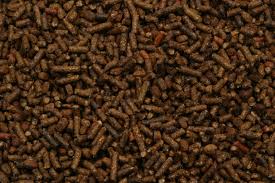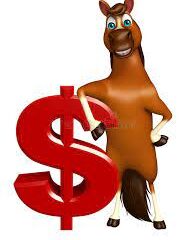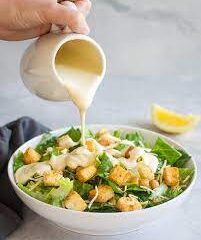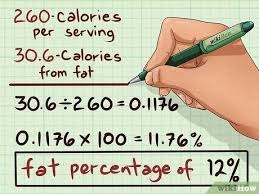The Three Types of Commercial Horse Feeds

One of the things that makes commercial feeds so confusing is a lack of understanding of the three basic categories of feed offered. The biggest problem with commercial feed is that it is often improperly used because there is a basic lack of understanding on which feed does what.
Before we jump into the different types of feeds let me remind everyone that the first, foremost and best part of a horse’s diet is forage. If a horse isn’t eating 15 to 2% of its body weight in forage as a minimum then making it up with feed is the wrong path with the exception of complete feed so let’s start there.
Complete Feed
Complete feeds are formulated to be total replacements for some or all forage in a horse’s diet. In terms of nutrition complete feeds tend to stay close to a high quality grass hay for protein, fiber and fat. One feed tag indicator that a complete feed is a true complete feed is that selenium is limited to .3 ppm where most concentrated feeds have selenium at .6 ppm. This is significant because if you are feeding 12 or 15 pounds of a concentrated feed as forage replacement you may be pushing the limit of selenium toxicity. The same theory applies to other nutrients in the feed hence the lower levels of each nutrient. Since complete feeds are to be used as forage replacement they are generally designed to be fed at a minimum of 6 pounds per day for a 1,000 pound horse to provide the full amount of essential nutrition. This is an important consideration since I often see a COMPLETE senior feed being fed at three or four pounds per day in addition to hay just because the owner has a 22 year old horse. I put “complete” in all caps just now because there are two types of senior feed, complete and concentrated and they are not interchangeable in application.
Complete feeds are not very common these days since good forage is typically readily available in most regions of the US. The most common complete feeds are senior feeds because although good forage may be available it won’t help a 32 year old horse with no teeth. That’s when we choose a complete feed and feed lots of it. Because of the consistency of nutrition and little or no waste a complete feed will usually work when feeding at a minimum rate of 1.2% of body weight.
Complete senior feed is also designed to rehydrate easily when soaked. Horses with some grinding surface may be fed complete senior feed dry and their saliva will readily break it down.
There are other applications besides poor dentition. Post colic feeding, any post operative recovery feeding, reintroducing malnourished horses to feed are a few of the applications for a complete senior feed.
A few years ago many feed companies introduced senior feeds for “active” horses with good teeth. These are concentrated feeds and are designed to be fed in addition to a full daily load of forage. Although the feed companies may say that these feeds are appropriate as complete feeds I urge caution because they are too nutrient dense to be fed in huge quantities. While it’s not common I have personal experience with horses that were having mineral toxicity issues when being fed 15 pounds of concentrated senior feed.
It’s just my opinion that part of the reason these feeds were introduced is for the horse moms who think that when their fur baby hits 20 he needs to be on senior feed. I have a large number of horses in their mid twenties at a reasonable amount of work and I keep them on plain old adult concentrated feeds because for many horses 20 is the new 10!
Concentrated Feeds
Concentrated feeds are designed to be fed in addition to a full diet of quality forage when a horse’s workload exceeds the calories and nutrients available in forage alone. Before we start dumping concentrated feeds into Sparky’s feed bucket she needs to be eating a minimum of 2% of her body weight in quality forage. 2% is in no way the upper limit for forage. If Sparky is a 1,000 pound horse in training and isn’t holding weight on 20 pounds of forage by all means feed her more hay. I am a terrible feed sales guy because I want everyone to feed forage first.
The primary application for concentrated feed is to provide a calorie and nutrient dense energy source as a SUPPLEMENT to forage. Concentrated feeds are not for building weight, they are for maintaining weight in a horse that is eating as much quality forage as possible. This is where people run into trouble with concentrated feeds and the feed takes the hit.
Concentrated feeds are not intended to be thrown at a “hard keeper” in huge volume to build weight. If Sparky has a target weight of 1,000 pounds and is doing two 30 minute walk trot lessons per week she requires around 14,000 calories per day to maintain weight. If Sparky is eating 20 pounds of grass hay per day she should be a good weight if not chubby, even a thoroughbred. If Sparky isn’t maintaining weight on 20 pounds of hay there may be a problem with teeth, ulcers, parasites or some other underlying condition that we don’t know about.
There are Sparkies out there who because of breeding need three or four pounds of feed to hold weight. I’d say many thoroughbreds fit that model so it’s not a big deal for these horses to require three or four pounds of concentrated feed to maintain weight. However, if Sparky is downing seven or eight pounds of feed a day plus a dozen fat supplements Sparky probably has a problem that you may be masking with all these extra calories.
It’s really easy to get into trouble with the basic feed then add all the supplements people experiment with. It’s no wonder commercial feeds have such a bad reputation. It’s not the feed, it’s the improper application.
Ration Balancer
Ration balancers are designed for my perfect unicorn horse that will maintain weight on forage alone and just need something to fill in the gaps for protein, amino acids and some essential nutrients.
The average minimum daily feed rate of concentrated feed for a 1,000 pound horse is between three and four pounds. A typical daily feed rate for a balancer is one pound per day for a 1,000 pound horse in maintenance to light work. If you compare feed tags between a balancer and a concentrated feed you should find that the balancer has around three times the nutrients per pound of the concentrated feed.
The most obvious application for ration balancers is the incorrectly named “easy keeper”. There is nothing easy about managing diet for a horse that is prone to weight gain. Ration balancers allow is to provide a full measure of nutrients to these horses with a minimum of extra calories. Look at a ration balancer as a protein shake for human easy keepers, like me. We get all our essential nutrition in a tight package without all the extra carbs and calories.
Adding Supplements
The supplement industry is a multibillion dollar enterprise and many to most of them really don’t add much to a good feeding program.
If you are feeding a high quality feed, appropriate to the horse’s age and workload fed in the proper quantity you will not need any additional nutritional supplements. A horse getting the proper load of protein and amino acids from their feed will not benefit from a hoof building supplement.
In the event you are not experiencing good results from your basic feed chances are it’s the wrong feed being fed at the wrong rate to the wrong horse.



4 Comments
Shirley · November 22, 2021 at 1:52 pm
I have a 22 year old Hanoverian mare in retirement at a large boarding facility. She has a barrel belly perhaps from having bred two foals. As recently as last winter,, one of the trainers at our barn from whom I purchased her remarked that she was fat so we reduced her barn supplied grain to a handful twice a day. Her outdoor forage is pretty meager and she has 5 or 6 other horses sharing her pasture.
.In late April of this year, she had what the Vet called “medical colic”. She stayed at Quakertown Clinic from Thursday through Monday for rehydration and monitoring.
Currently, she hadn’t been eating her stall hay but seems to like the latest batch that the barn is supplying. I graze her 3-4 times a week on lawn grass for about 45 minutes at a time. As she was not liking her grain, I purchased Purina Senior Feed. She loves that and eats it right up. I am ready to buy another bag but am not sure this was the proper feed for her. She also gets Smartpak supplements – Farrier’s Formula, SmartVite Thrive Senior Pellets, SmartDigest Ultra Pellets and SmartFlex Senior pellets. Yes, I spoil her and she is like a pet to me.
Please recommend an appropriate feed for her. Thanks!
Jim Fiorini · December 14, 2021 at 9:35 am
Hi Shirley,
Check you email…
Sue · February 25, 2023 at 11:23 pm
Hi, I have a 21 yr old mare that gets fat on air. She’s always overweight summer and winter. I don’t feed a supplement.What excatly is a ration balancer? This is all new to me. When looking at bags in the store I don’t see those words on any bags. Is Equi-Shine a balancer? How does a horse loose weight with a balancer. Thanks, Sue
Jim Fiorini · March 19, 2023 at 9:59 am
Hi Sue,
Simply put a ration balancer is like a human protein shake for horses. All the nutrition that they need in a concentrated package with minimal fat and calories.
Some good choices are Purina Enrich, ProElite Grass Advantage or Gro n Win. There’s an entire article on the blog that explains RBs.
In order for your mare to lose weight you must decrease her calories or increase her exercise. I have a very easy keeping mare so I feel your pain.
Slow feed nets and soaking her hay for 30 minutes will help with weight loss.